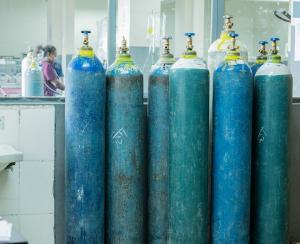NEW DELHI, July 27: The Centre has asked the states and Union Territories to provide data on deaths related to oxygen shortage during the second Covid wave earlier this year.
The information will be collated and presented in Parliament before the monsoon session ends on August 13, official sources said.
“The Centre has written to states for data on deaths related to oxygen shortage. The data is likely to be presented in Parliament before the monsoon session ends on August 13,” officials said.
Responding to a question by Congress MP KC Venugopal on July 20, minister of state (health) Dr Bharti Pravin Pawar had said, “Since health is a state subject, all states and UTs reports cases and deaths to the Union health ministry on a regular basis. However, no deaths due to lack of oxygen have been specifically reported by states and UTs.”
Pawar’s response, which came on day 2 of the monsoon session, triggered much furor among the Opposition ranks. “This is a blind and unconcerned government. People have seen how many of their near and dear ones have died because of lack of oxygen,” Venugopal had said.
However, at least eight states, including the non-BJP governed Maharashtra and some other opposition-ruled states, too, said that no death took place due to lack of oxygen.
During the second Covid-19 wave, which was at its peak in April and May, several hospitals from across the country reported an acute shortage of medical oxygen. In many cases, hospitals were forced to approach courts seeking directions to authorities to facilitate its supply. The ministry of railways ran special Oxygen Express trains to deliver oxygen to states.
A surge in infections across India had put immense pressure on the country’s health infrastructure. Critical supplies such as those of hospital beds, drugs, and vaccines fell woefully short.
Among these, the most devastating was the shortage of medical oxygen. Such was the shortfall that India had to import the vital gas from several countries on an emergency basis. Several people died breathless.
In Goa, over 80 people died at a state-run medical facility over five days in May. In Tirupati, Andhra Pradesh, 11 Covid patients admitted to the ICU of a hospital lost their lives after supply was disrupted. At a Hyderabad facility, seven succumbed at a government hospital during a two-hour cut in supply.
Several states went to court over oxygen sharing, while the government flagged off Oxygen Express trains to ensure supplies.
Last month the Centre even vetoed an investigation ordered by the Delhi government into the deaths caused by a lack of oxygen supply. At one hospital in Delhi, 21 patients died due to oxygen shortage and the matter is pending in the High Court.
However, despite all those headline-making events, the Centre told Parliament earlier this month that “no deaths due to lack of oxygen have been specifically reported by states and Union Territories”. It said the states had not provided any data on this front.
Meanwhile, the Centre held the Kerala government responsible for the surge in Coronavirus cases in the southern-most state pointing out that it was not focusing on containing Covid, as a result of which up to 50 per cent of the new cases were being reported from that state, along with Maharashtra, Health Ministry sources said.
“Kerala is not focusing enough on containment…They are focused more on mitigation process of treating cases than containment,” the source said. “Up to 50 per cent of new cases are coming from Kerala and Maharashtra. The fatalities are low because their health infrastructure is good.”
Kerala has been reporting a high number of infections for the past many weeks even as the overall numbers have been falling rapidly since the second wave peak across India. The southern state registered 22,129 new cases and 156 deaths today, with a test positivity rate of 12.35 per cent.
It has had to stop the vaccination drive as many of its districts, including capital Thiruvananthapuram, have run out of doses, state Health Minister Veena George had said. An increasing ‘R’ value, or Covid reproduction rate, in Kerala had earlier this month triggered concerns of a renewed wave, which could even fuel a national spike.
The state government, however, was not unduly worried over the issue claiming it to be “part of the state’s strategy in fighting the pandemic and was no cause for alarm.” George said overall infections have plateaued and a similar trend was seen in the first wave, too. She had termed the phenomenon “dragging the wave.”
George countered suspicions of slippage in caution. Despite a high share of susceptible persons in the state’s population, only 20 per cent or 21 per cent of them may have been infected till July 10, she had said.
(Manas Dasgupta)

